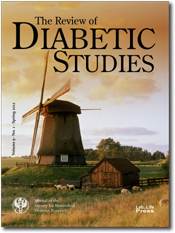Reviews
| Rev Diabet Stud,
2012,
9(1):6-22 |
DOI 10.1900/RDS.2012.9.6 |
Genetic and environmental factors associated with type 2 diabetes and diabetic vascular complications
Mariana Murea, Lijun Ma, Barry I. Freedman
Department of Internal Medicine, Section on Nephrology, Wake Forest School of Medicine, Winston-Salem, North Carolina, USA
Address correspondence to: Mariana Murea, email: mmurea@wakehealth.edu
Abstract
Faced with a global epidemic of type 2 diabetes (T2D), it is critical that researchers improve our understanding of the pathogenesis of T2D and related vascular complications. These findings may ultimately lead to novel treatment options for disease prevention or delaying progression. Two major paradigms jointly underlie the development of T2D and related coronary artery disease, diabetic nephropathy, and diabetic retinopathy. These paradigms include the genetic risk variants and behavioral/environmental factors. This article systematically reviews the literature supporting genetic determinants in the pathogenesis of T2D and diabetic vasculopathy, and the functional implications of these gene variants on the regulation of beta-cell function and glucose homeostasis. We update the discovery of diabetes and diabetic vasculopathy risk variants, and describe the genetic technologies that have uncovered them. Also, genomic linkage between obesity and T2D is discussed. There is a complementary role for behavioral and environmental factors modulating the genetic susceptibility and diabetes risk. Epidemiological and clinical data demonstrating the effects of behavioral and novel environmental exposures on disease expression are reviewed. Finally, a succinct overview of recent landmark clinical trials addressing glycemic control and its impact on rates of vascular complications is presented. It is expected that novel strategies to exploit the gene- and exposure-related underpinnings of T2D will soon result.
Fulltext:
 HTML
, HTML
,  PDF
(310KB) PDF
(310KB)
| Rev Diabet Stud,
2012,
9(1):23-35 |
DOI 10.1900/RDS.2012.9.23 |
The Diabetic Lung - A New Target Organ?
Dario Pitocco1,2, Leonello Fuso2,3, Emanuele G. Conte3, Francesco Zaccardi1, Carola Condoluci3, Giuseppe Scavone1, Raffaele Antonelli Incalzi4, Giovanni Ghirlanda1
1Diabetes Care Unit, Catholic University of Rome, Italy
2Equally contributed to the paper
3Respiratory Disease Unit, Catholic University of Rome, Italy
4Geriatric Medicine, University Campus Bio-Medico, Rome, Italy
Address correspondence to: Dario Pitocco, MD, Servizio di Diabetologia, Policlinico A. Gemelli, L.go A. Gemelli 1, 00168 Roma, Italy, e-mail: dario.pitocco@rm.unicatt.it
Abstract
Several abnormalities of the respiratory function have been reported in patients with type 1 and type 2 diabetes. These abnormalities concern lung volume, pulmonary diffusing capacity, control of ventilation, bronchomotor tone, and neuroadrenergic bronchial innervation. Many hypotheses have emerged, and characteristic histological changes have been described in the "diabetic lung", which could explain this abnormal respiratory function. Given the specific abnormalities in diabetic patients, the lung could thus be considered as a target organ in diabetes. Although the practical implications of these functional changes are mild, the presence of an associated acute or chronic pulmonary and/or cardiac disease could determine severe respiratory derangements in diabetic patients. Another clinical consequence of the pulmonary involvement in diabetes is the accelerated decline in respiratory function. The rate of decline in respiratory function in diabetics has been found to be two-to-three times faster than in normal non-smoking subjects, as reported in longitudinal studies. This finding, together with the presence of anatomical and biological changes similar to those described in the aging lung, indicates that the "diabetic lung" could even be considered a model of accelerated aging. This review describes and analyses the current insight into the relationship of diabetes and lung disease, and suggests intensifying research into the lung as a possible target organ in diabetes.
Fulltext:
 HTML
, HTML
,  PDF
(153KB) PDF
(153KB)
|



